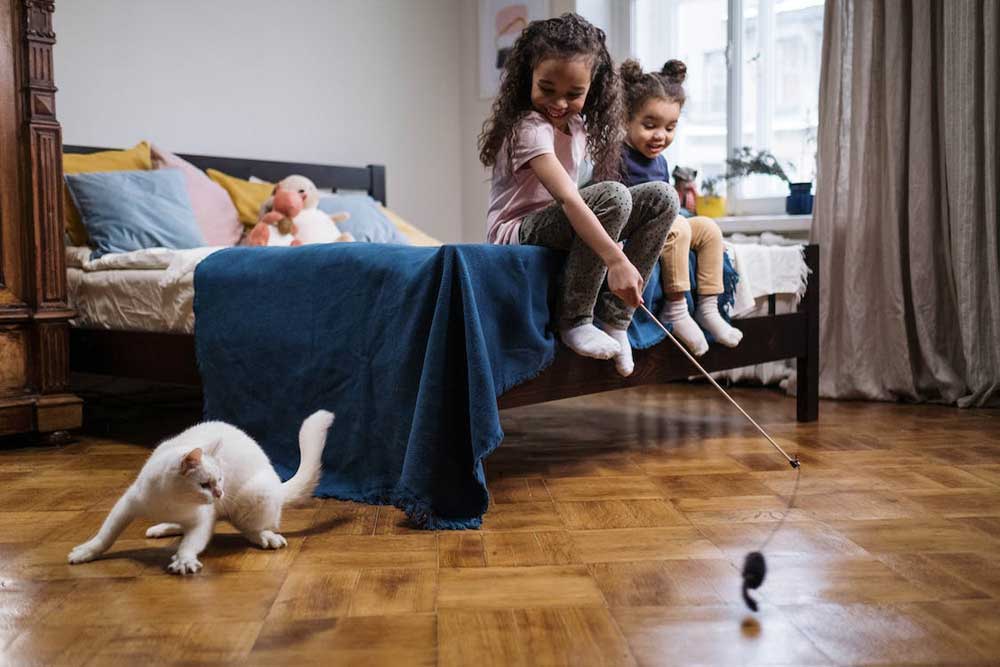-
9 Tips for Room Sharing Between Siblings
Room sharing between siblings is more than a necessity. It can be a truly enriching experience. We’ll look at the various benefits of having siblings share a room and effective ways to mitigate common challenges. You’ll also find our top tips for success when implementing this arrangement. From ensuring they’re sleeping on the best mattresses to carving out personal space in a shared environment, we’ll arm you with the info and knowledge you need to help your kiddos make it work.

What Are the Benefits of Siblings Sharing the Same Bedroom?
Sharing a bedroom with a sibling has several advantages that go beyond simple space-saving. It can be a natural setting for siblings to strengthen their relationship through shared conversations and activities. At the same time, observing each other’s bedtime routines often leads to improved sleep habits for both. The setup is particularly helpful in homes with limited space, as it allows for better use of the available rooms.
Room sharing isn’t just about squeezing two kids into one space — it has tangible benefits for their personal development as well. When siblings share a bedroom, they often have better communication with each other, which fosters emotional bonds. They are more likely to feel secure during bedtime, knowing that someone familiar is nearby. Finally, sharing a room makes it easier to allocate remaining rooms in the house for other purposes, such as creating a guest room or study.
- Sibling Bonding: Sharing a room gives siblings extra time for conversations and activities, fostering a closer relationship.
- Improved Sleep Habits: Observing each other’s bedtime routines often leads to better sleep practices for both siblings.
- Security: Children often feel more secure and fall asleep more easily when they know a sibling is in the same room.
- Efficient Use of Space: This arrangement frees up other rooms for different uses like a study or guest room.
How Can I Get My Kids to Share a Room Peacefully?
Designed right, a shared bedroom can give each child a sense of ownership. Here are our top tips for sharing a room with a sibling and doing it peacefully:
1) Establish a Routine for Bedtime
A consistent bedtime routine helps children wind down and signals it’s time for sleep. The routine creates a predictable environment, making it easier for siblings to adjust to the shared space. Both siblings should participate in setting up the routine to ensure everyone is comfortable with it.
2) Use Staggered Bedtimes
Having siblings go to bed at different times helps minimize disturbances. Usually, the younger child goes to bed first, followed by the older one. This gives each child time to fall asleep without the other causing distractions.
3) Plan a Gradual Transition to a Shared Room
When transitioning siblings to share a room, it’s important to ease them into it. You can start by having the younger sibling nap in the older child’s room. Gradually increase the time spent together in the room before making it a full-time arrangement.
4) Consider Age Appropriateness for Room Sharing
The right age for siblings to share a room depends on the children’s comfort levels and the parents’ judgment. Toddler-aged kids can often share a room with an older sibling, and even a newborn can share space if proper precautions are taken.
5) Minimize Sleep Distractions
Creating a conducive sleep environment is important. A dark, quiet room and the use of white noise can help siblings fall asleep, even if one is still awake. Staggered bedtimes also contribute to minimizing distractions.
6) Manage Nap Times Effectively
Scheduling naps at different times or using white noise can help when siblings share a room. This ensures that one child’s naptime activities don’t interfere with the other’s rest.
7) Create Individual Space in a Shared Room
Even in a shared setting, each child should feel they have their own space. This can be achieved through room dividers like shelves, different colored beddings or letting each child personalize their part of the room.
8) Make the Shared Space Comfortable for Both
Both children should feel at ease in their shared room. Allowing each to have input in decorating creates a space that reflects their individual personalities while promoting a sense of sharing.
9) Consult a Pediatric Sleep Expert
If sleep issues persist despite these strategies, consider seeking the help of a pediatric sleep consultant trained in sleep coaching. They can offer tailored solutions to address specific sleep habits and challenges your children may face.
FAQ on Siblings Sharing Rooms
When is it appropriate for a toddler to share a bedroom with an older sibling?
A toddler can generally move into an older sibling’s room after transitioning from a crib to a twin bed or even a full-size mattress, usually around two to three years old. This makes toddler sleep easier to manage and allows space for each child in the room.
What is the recommended age for room sharing with a newborn and an older child?
Experts suggest waiting until the baby is at least six months old before moving siblings into the same room. This gives enough time to establish stable sleeping patterns and a dependable routine for the baby.
How does sharing a room affect a child’s sleep quality?
When children are sharing a room, it can lead to better sleep habits. The older child’s sleep patterns tend to influence the younger sibling, establishing a consistent routine for both.
What are some common problems when siblings share a room, and how can they be addressed?
Problems may arise for whatever reason, but early intervention can help ensure successful room-sharing. One common issue is the lack of personal space. This can be resolved by allocating a separate space for each child, perhaps using room dividers or bunk beds.
What kind of bed arrangement works best for siblings sharing a room?
The choice can vary, but bunk beds with Nectar mattresses are a popular option. These allow for good use of space, especially if the room is small, and they can provide a comfortable sleep experience.
When should siblings move from sharing a room to having separate rooms?
There’s no definitive age for moving siblings into separate rooms. It largely depends on the children’s comfort and needs. If either sibling expresses a strong desire for personal space or if sleep disruptions become a major issue, it may be time to consider separate rooms.
What are some tips for maintaining personal space when siblings share a room?
To maintain personal space, consider room dividers or allocating different areas of the room for each child’s belongings. You can also allow each child to personalize their separate space, making it feel more like their own.
The Positive Impact of Kids Room Sharing on Family Life
Room sharing between siblings has shown numerous benefits — from fostering stronger emotional bonds to promoting good sleepers. You’ve read about practical strategies for implementing this arrangement successfully, and now it’s time to apply what you’ve learned. Whether your children are sharing a room by choice or out of necessity, you have the tools to make it a positive experience for everyone involved.
Remember, challenges may arise, but they are surmountable with the right approach. Keep in mind that your efforts in making room sharing work smoothly can provide long-term benefits for your children, strengthening their relationships and instilling valuable life skills.





